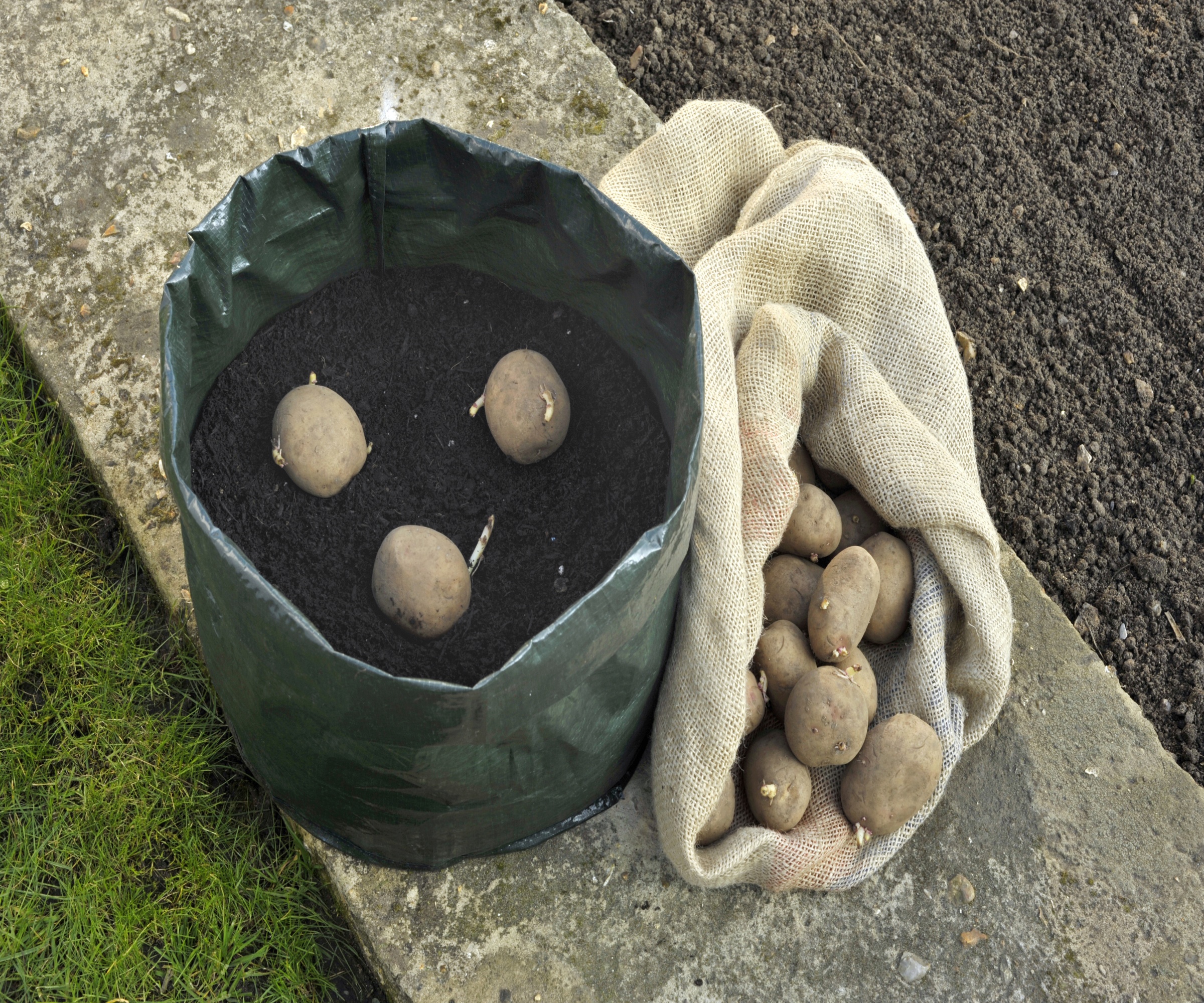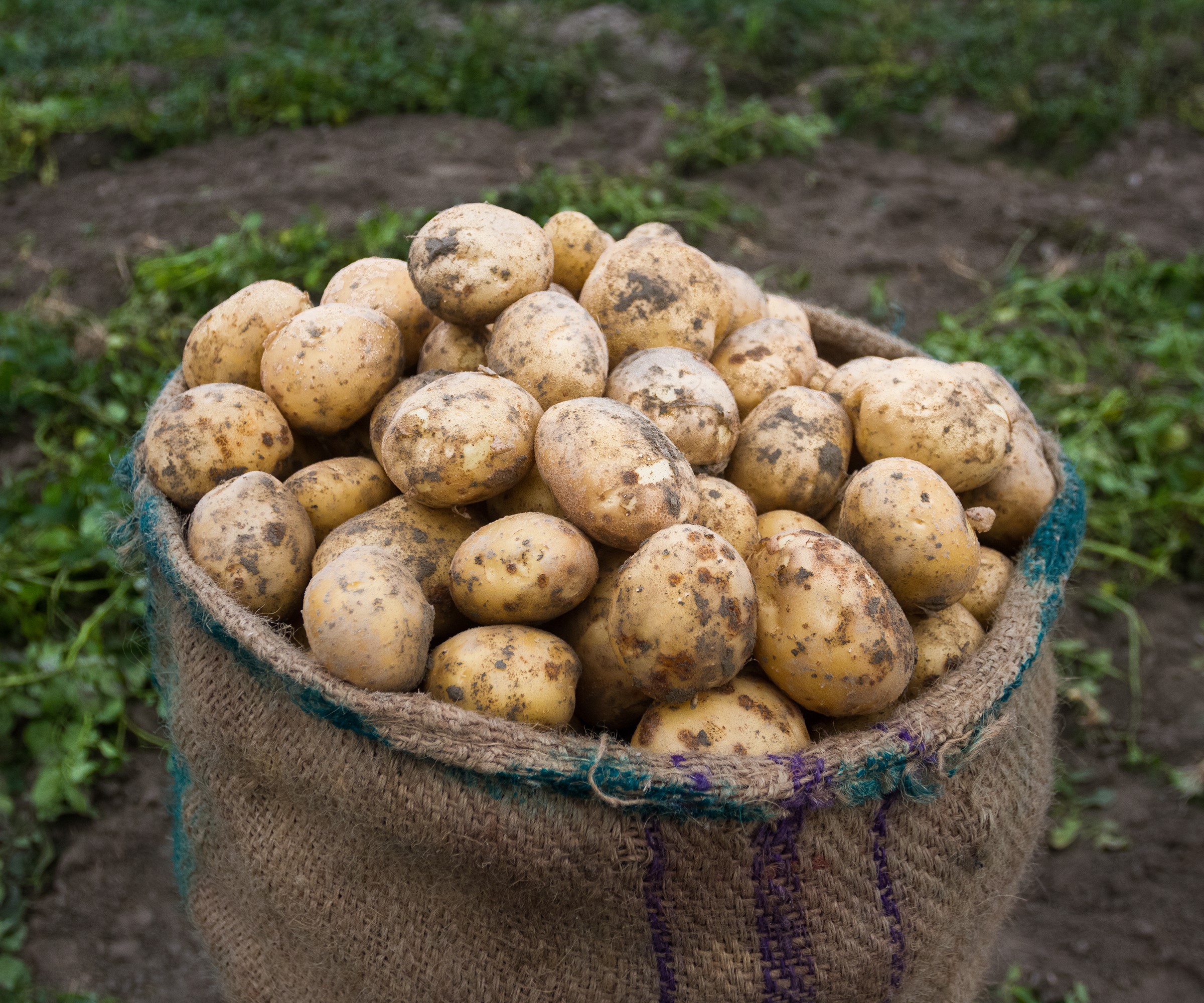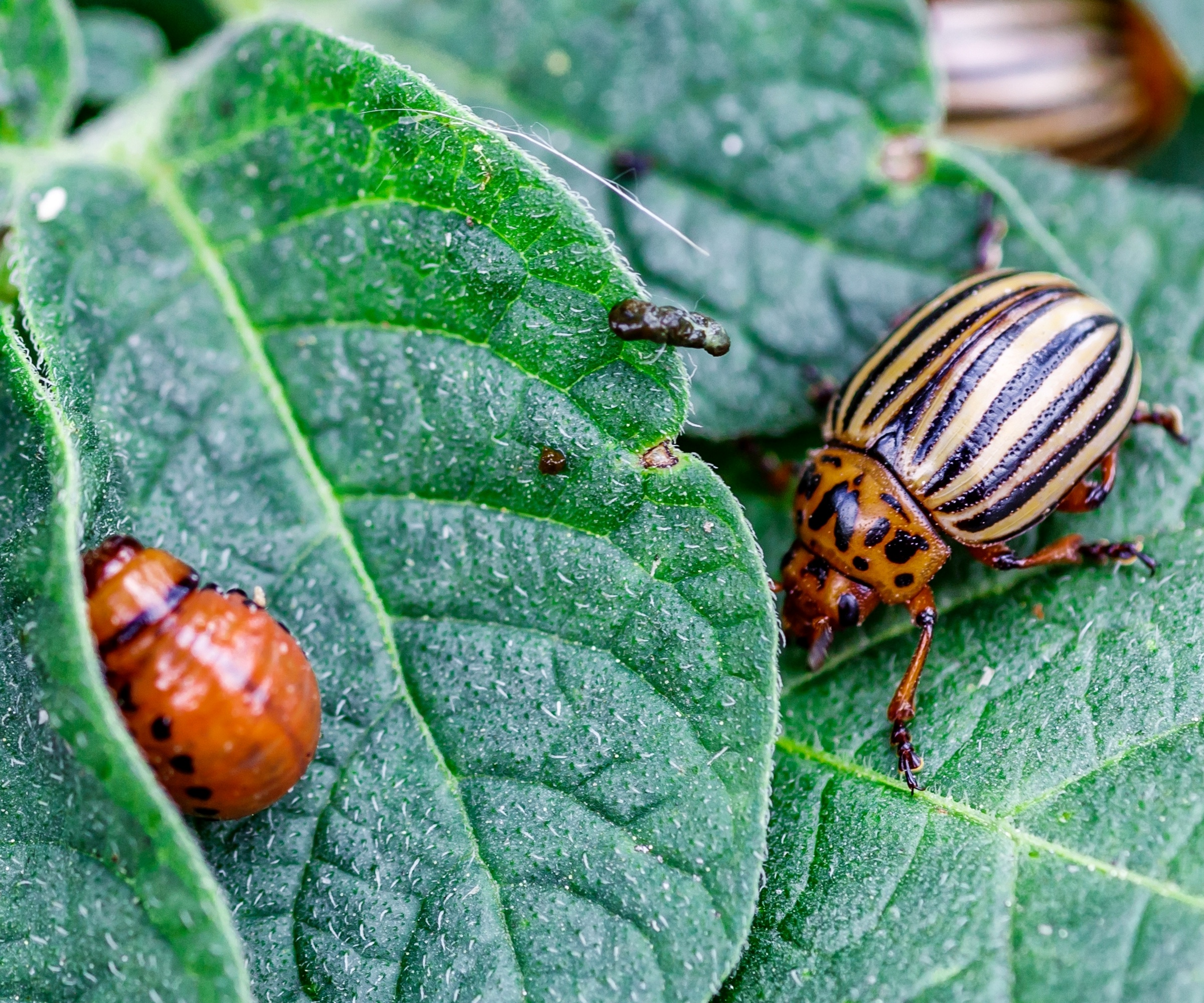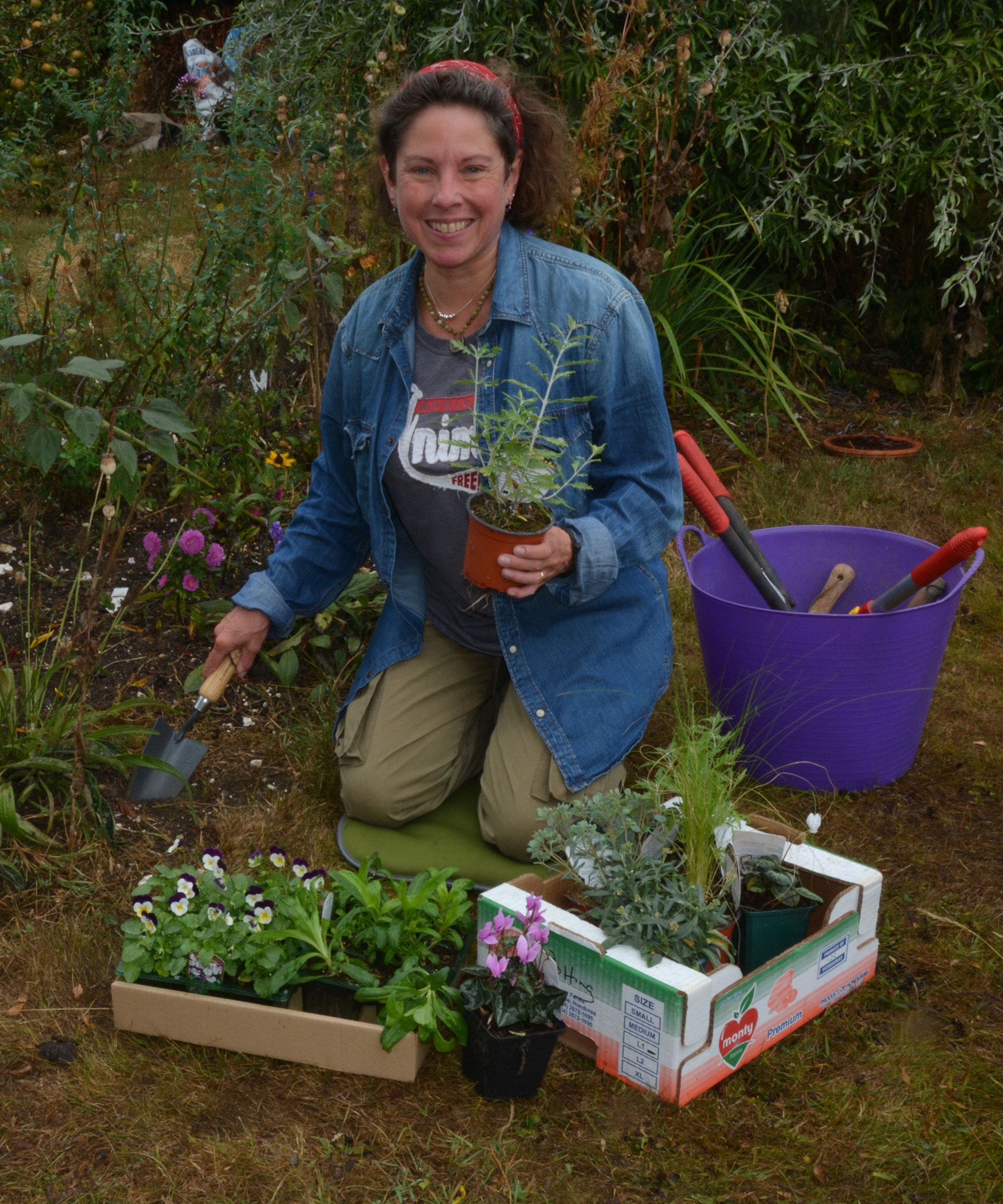How to grow potatoes vertically – for tasty tubers in tiny garden spaces, try growing them in a tower
Expert advice for growing potatoes in a tower, when your outside space is limited


Gone are the days when people only grew potatoes in large beds – the trend of growing food vertically is becoming more and more common, which is brilliant for people with limited outside space.
Because I don't have much space for fruit and vegetables, I grow potatoes each year in a tower on our patio.
It is neat and easy, taking up hardly any space but producing an enviable harvest. Potato towers are perfect for compact urban gardens, balconies and terraces and here I share everything you need to know about growing a crop of potatoes vertically.
How to grow potatoes vertically in a tower

Potatoes grow well in containers making them a great crop for balconies and small yards
Potato towers are wire cages standing four or five foot tall that contain layers of straw, compost and seed potatoes.
They are easy to make and can fit into a corner of even a small balcony or yard. I think it is always worth including potatoes in your small vegetable plot ideas because they are such a space-efficient and versatile crop.
Depending on the variety, they will be ready for harvest from early summer right through to the fall, meaning you can grow them as part of your homegrown Christmas dinner.
Equipment you will need

Start your vertical potatoes by placing the seed potatoes on a layer of good quality potting soil
Towers are easy to construct and can be reused year after year, making them a sustainable way to grow potatoes and other tubers.
Design expertise in your inbox – from inspiring decorating ideas and beautiful celebrity homes to practical gardening advice and shopping round-ups.
You will need wire cutters such as these Hurricane snips on Amazon, a length of chicken wire or wire mesh, like this galvanized mesh from Amazon, that is around 4 foot long and 3 foot high.
You'll need zip ties like these heavy-duty cable ties from Amazon.
You can leave your tower as it is, but if you are worried about making a mess or want to prevent voles or mice from burrowing in and nesting, you can stand it in a sack or bag so the base is contained.
I have used burlap sacks, like these at natural jute bags on Amazon, wooden half-barrels and even old plastic compost sacks. Pierce the sacks with scissors first so the compost didn’t become waterlogged.
You will also need a good quality potting soil, like R&M Organics Premium Compost on Amazon that is suitable for growing vegetables, and some straw.
Generally speaking, potatoes are not fussy about their container as long as it doesn't let in the light as this will turn the tubers green, and drains well.
How to grow potatoes in a tower

Potatoes like warmth, so a south-facing balcony is ideal. Alternatively, position it where it will get the most sun and we recommend building it there so you don't need to move a full, heavy tower later on.
- Start by making a cylindrical bin using the wire mesh. Use wire cutters to cut a piece of mesh that is roughly two feet in diameter and four foot tall, as this will give you plenty of depth for your potatoes but also not be too difficult to access.
- Tie it together using the zip ties and if you want it to be more stable you could attach the wire frame to a sturdy rebar stake like these heavy-duty ones on Amazon and insert it into the soil.
- Now line the base of your tower with a layer of straw 2-3 inches deep, and create a hollow in the middle for your compost. The straw will help support the structure, improve drainage and also insulate your potatoes.
- Now add your first layer of potatoes. These should be placed on the compost and against the sides of the straw 'nest' with their eyes where the shoots will develop pointing outwards.
- Cover the potatoes with a thin later of compost and water them well.
- Now make another straw nest on top of the potatoes, add more compost and potatoes, water them well and continue this layering process, as though you are lasagna gardening, until you are 4 inches from the top of the tower.
- As the potatoes grow, shoots will erupt through the sides of the tower and the top growth of the top later of potatoes will emerge from the top.
- As your plants grow, keep them well watered but make sure the tower drains well to prevent your crop from rotting.
Growing and harvesting tower potatoes
Fertilizing potatoes will definitely improve your crop, and you can buy specific potato fertiliser like this liquid feed on Amazon which is designed to give growing tubers all the essential plant nutrients they need.
Harvest your potatoes once the flowers have died back. If you don't have containers with side openings, carefully dip your hands into the container from the top and remove as many tubers as you need.
At the end of the season, when the top growth has died back, empty the compost and harvest the rest of your potatoes. You can expect each plant to produce around 2 pounds of tubers.
The best potato varieties for vertical growing

'Red Pontiac' is a popular potato variety for vertical growing
Indeterminate potatoes, which take 80 to 100 days from planting to harvest, grow tubers along their stems making them perfect for vertical growing.
Popular varieties include the heirloom tuber ‘Strawberry Paw’, high yielding ‘Snowden’, purple-skinned ‘Kennebec’ which stores well after harvest, ‘Red Pontiac’ which is good for boiling and mashing and ‘Umatilla Russet’, a classic potato popular for making fries.
Determinate varieties that only produce one layer of tubers are also known as baby or new potatoes. They are quick to ripen and are usually ready for harvest 70-90 days after planting.
The best varieties include the versatile ‘Yukon Gold’ which is good for boiling and roasting, ‘Norland’ which has good disease resistance, red-skinned ‘Chieftain’ (good storage) and the heavy-cropping ‘Cal White’.
A wide variety of seed potatoes, along with growing advice, can be found at Burpee.
Potato pests

Colorado potato beetles and their larvae are a major potato pest
Like all plants, potatoes can suffer from pest attack above and beneath the soil.
The main ones to watch out for are aphids, which attack the top growth, sucking sap which weakens the plant and can spread diseases and Colorado potato beetle.
These beetles are a major threat and can decimate potato plants, eating the leaves to the point where there is no top growth left.
They also attack tomato plants, eggplants and peppers. At soil level cutworms can chew through stems, while slugs hang out within the compost and burrow into the potato tubers.
Where possible, use natural pest control methods and nematodes to protect your plants, removing pests by hand as soon as you see them and encouraging pest predators such as garden birds, ladybugs and wasps into your yard.
You can even use cooked potatoes to attract garden birds as they are a safe and nutritious treat for them.
However, if pest infestations are bad, we recommend using an organic solution such as Colorado Beetle Beater at Amazon, which also combats a wide range of unwanted critters.
FAQs
What can I use if I'm unable to build a tower?
Tall, robust bags or containers for growing fruit and vegetables are widely available.
We like these reusable 10-gallon potato growbags on Amazon. They are large enough for good cropping and have side openings that make it easier to access your potato harvests.
Can I grow sweet potatoes vertically?
If space is tight you can definitely grow sweet potatoes in containers.
They are usually a sprawling crop so cultivating them in containers is ideal for small gardens, though they will need a large container or grow bag. They also need warmth, so wait to plant until well after the last frosts.
Can I reuse potato compost?
As a way of saving money, creating a zero-waste garden and as a form of sustainable gardening, you can reuse the compost and straw from your potato tower after harvest.
The compost can be used as a soil conditioner and you can either adad the straw to your compost heap or use it to protect plants in winter once you have made sure it doesn't contain pests.
However, if your plants were struck by potato blight it is a safe precaution to dispose of the compost instead.
Potatoes are one of the easiest and most satisfying vegetables to grow and because they can be grown in containers, they are the perfect solution if you are considering what to grow in a small yard, patio or balcony.

Ruth is a Contributing Editor for Homes & Gardens, and formerly Gardening Editor of Amateur Gardening magazine. She is horticulturally trained, with a qualification from the Royal Horticultural Society. Her work for Amateur Gardening, the world's oldest weekly gardening publication, involved matching gardening tasks with each season, covering everything from sowing and planting, to pruning, taking cuttings, dealing with pests and diseases and keeping houseplants healthy. She is an expert in ornamental plants and edible crops, and everything she writes about and photographs is in her own garden, that has been a work in progress since her family moved there in 2012.
You must confirm your public display name before commenting
Please logout and then login again, you will then be prompted to enter your display name.